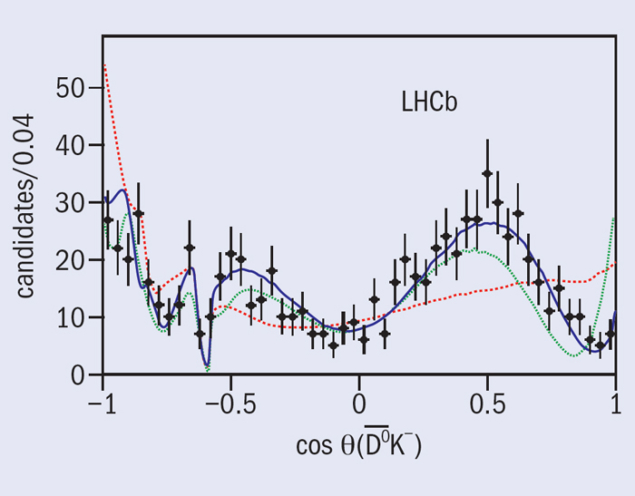The LHCb collaboration has shown that a D0K– structure with invariant mass 2860 MeV/c2 is composed of two resonances, one with spin 1 and the other with spin 3. This is the first time that a heavy flavoured spin-3 particle has been observed, and it should lead to new insights into hadron spectroscopy.

The LHCb experiment is designed primarily to study CP violation and rare decays of b hadrons. However, the large samples of decays collected are also allowing detailed studies into the spectroscopy of lighter particles that are produced in various different decay channels. LHCb has already determined the quantum numbers of the X(3872) particle and established that the Z(4430)+ state is indeed a resonance. Now, for the first time, the collaboration has used amplitude analysis techniques to study Bs0 → D0K–π+ decays. The well-defined initial and final states allow the determination of the spin and parity of any intermediate D0K– resonance through the angular orientation of the decay products.
The figure shows the angular distribution of events seen in a peak with D0K– invariant mass around 2860 MeV/c2. The data points are well fitted by a model that includes both spin-1 and spin-3 particles (solid blue curve). The models with either only a spin-1 (red curve) or a spin-3 (green curve) resonance are excluded with significance more than 10σ. A similar analysis of the angular distribution for events around the D*s2(2573)– peak establishes, for the first time, that this resonance is indeed spin 2. In addition, the mass of this resonance is determined much more precisely than previous measurements, suggesting that renaming as D*s2(2568)– might be in order.
The identification of a spin-3 resonance at a mass of 2860 MeV/c2 fits with the theoretical expectation for, in spectroscopic notation, the 2S+1LJ = 3D3 state, where S is the sum of the quark spins, L is the orbital angular momentum between the quarks and J is the total spin. It remains to be seen whether the production rate can be explained, because states with spin greater than two have never previously been observed in B-meson decays. With further analyses of the large samples available from LHCb and its upgrade, a new era of heavy-flavour spectroscopy could be beginning.
Further reading
LHCb collaboration 2014 LHCb-PAPER-2014-035, CERN-PH-EP-2014-183, to be submitted to Phys. Rev. Lett. arXiv:1407.7574 [hep-ex]
LHCb collaboration 2014 LHCb-PAPER-2014-036, CERN-PH-EP-2014-184, to be submitted to Phys. Rev. D. arXiv:1407.7712 [hep-ex]








